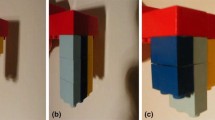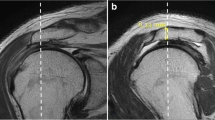Summary
Mechanical irritations of the supraspinatus tendon due to a reduction of the subacromial space are considered to be a potential cause of supraspinatus outlet syndrome. The aim of the current study was, therefore, to provide a method of improved measurement of the acromiohumeral distance and the evaluation of the acromial shape. In seven patients aged 50–60 years with unilateral supraspinatus outlet syndrome, imaging with standardized, high-resolution computed tomography (CT) was performed in order to demonstrate the acromion and the subacromial space three-dimensionally. The acromiohumeral distance was measured in three reconstructed frontal sections, and the two sides of each patient were directly compared. The acromial shape was compared with the classification of Bigliani as derived from conventional radiography.
Whereas the Constant Score was found to be significantly reduced in the diseased shoulders (p < 0.01), the acromiohumeral distance was not significantly lower in three standardized frontal sections. In five cases the classification of the acromial form from the conventional radiograph was confirmed by 3D CT, whereas in two cases it was shown to be different. Our results suggest that primary or secondary changes of the acromial form can be more accurately evaluated with 3D CT than with conventional radiography. A direct comparison of the two sides in patients with supraspinatus syndrome does not suggest a reduction of acromiohumeral distance in the diseased shoulder.
Zusammenfassung
Eine mechanische Irritation der Supraspinatussehne aufgrund einer Einengung des subakromialen Raumes wird als mögliche Ursache des Supraspinatus-outlet-Syndroms angesehen. Ziel der vorliegenden Studie war die Entwicklung einer Methode zur verbesserten räumlichen Messung akromiohumeraler Distanzen und zur Beurteilung der Akromionform in der dreidimensional rekonstruierten Computertomographie (CT). An 7 Patienten mit einseitigem Supraspinatus-outlet-Syndrom wurde das Akromion und der subakromiale Raum aus hochauflösenden CT-Schnitten dreidimensional (3D-) rekonstruiert. Die akromiohumerale Distanz wurde in 3 rekonstruierten Frontalschnitten gemessen und auf der gesunden und erkrankten Seite verglichen. Die Akromionform wurde der Klassifikation nach Bigliani im konventionellen Röntgenbild gegenübergestellt.
Die akromiohumerale Distanz war an der betroffenen Schulter nicht signifikant kleiner als auf der gesunden Seite. In 5 Fällen konnte die Klassifikation der Akromionform im Röntgenbild in der 3D-CT bestätigt werden, in 2 Fällen ergab sich eine abweichende Beurteilung. Die Ergebnisse legen nahe, daß mit der 3D-CT eine verbesserte Beurteilung der Akromionform und der akromiohumeralen Distanz möglich ist.
Similar content being viewed by others
Author information
Authors and Affiliations
Rights and permissions
About this article
Cite this article
Lochmüller, EM., Anetzberger, H., Maier, U. et al. Acromiohumeral distance and acromial shape assessed by three-dimensional computed tomography in patients with supraspinatus outlet syndrome. Unfallchirurg 100, 874–879 (1997). https://doi.org/10.1007/s001130050207
Issue Date:
DOI: https://doi.org/10.1007/s001130050207




